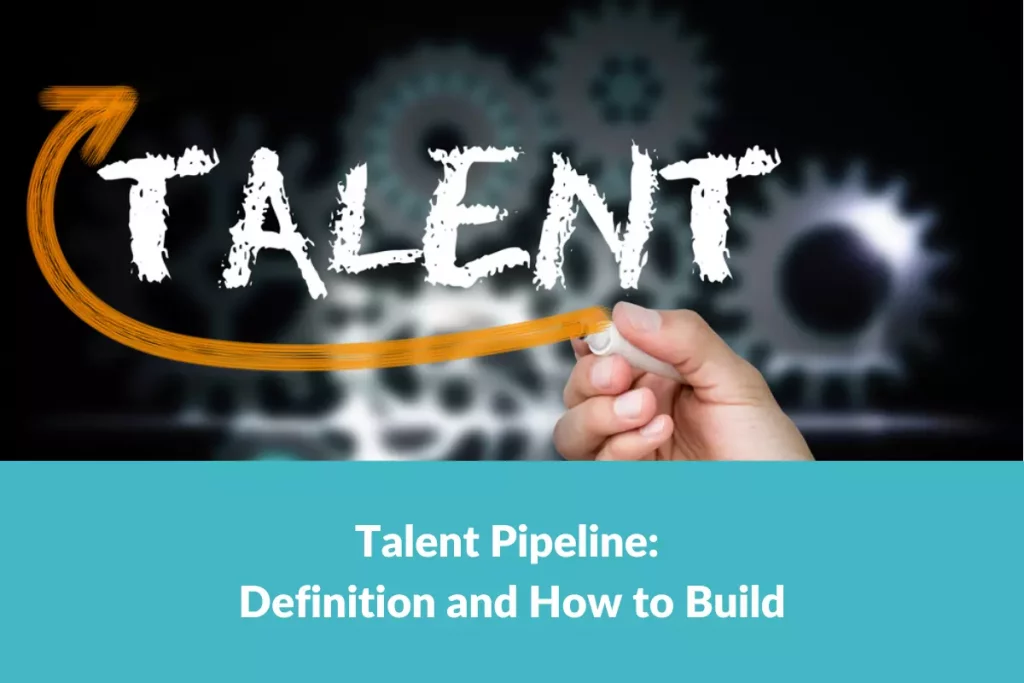How candidates interact with recruiters and apply for open positions has fundamentally changed. Gone are the days of relying on the best talent to apply organically. To succeed in the long term, it’s essential to be proactive, targeting candidates who are an excellent fit for the company and building a relationship.

Talent Pipelines should be a critical part of your strategy if you’re looking to move to a more proactive recruiting model. But what is a talent pipeline? We have the exact answer here!
What Is the Talent Pipeline?
A talent pipeline is a ready pool of candidates who are qualified and prepared to fill critical roles within organizations as soon as they open.
These on-hold talent pools may include promising internal employees that can be promoted from within your organization and candidates from many external sources, such as online job portals, referrals, and career web pages.
A pipeline of passive and active candidates will help in proactive and perceptive workforce planning. With a ready pool of the right talent, you can expect a considerable reduction in the time and cost to hire.
These days, most large organizations don’t wait for talent to come to them. Instead, they prepare prospective candidates before the need to fill open positions arises.
What Are the Advantages and Disadvantages of the Talent Pipelines

Developing a talent pipeline accomplishes much more than just delivering structure to your hiring process. Let’s take a look at some key pros and cons of establishing a good talent pipeline framework:
Pros
Better candidates
- Reduce the rush
Rather than rushing to find candidates for immediate needs, employers take a more long-term approach. The hiring target is communicated well in advance, so they have a good idea of the type and number of candidates they need.
They have enough time to focus on searching for the best candidates instead of submitting the first applicants they find or who are immediately available.
- Reduce reliance on serendipity
It typically takes a significant amount of work to find the perfect candidate at the right time when your organization has the ideal role for them. This can be a deeply frustrating process for recruiters. They find a great candidate but cannot do anything with him as there are no open positions.
A talent pipeline will help you deal with this issue. It allows you to nurture exceptional candidates that are not ready to move or create “evergreen jobs” that are always open, letting you hire the top candidate whenever they become available.
Engage passive candidates
Passive candidates are not actively looking for new opportunities, which means they may never get access to your job postings.
Unfortunately, most of the market consists of passive talent (not active job seekers). So, if you want to compete for the best talent, it is essential to attract them at all costs.
The talent pipeline allows you and your team to identify and develop a relationship with those candidates without pushing specific job openings.
Better candidate experience
The talent pipeline is considered an entirely candidate-centric process. Organizations are not geared towards driving candidates to job postings and expect that they will apply.
Instead, they focus more on developing a robust relationship and engaging potential candidates on their terms.
It must be addressed, especially in the era where the candidate experience is instrumental to hiring success.
Improved diversity
Talent pipelining and pipelining is one of the best tactics organizations are leveraging to increase.
The truth is that many organizations have difficulty finding candidates that fit their diversity requirements. Fortunately, the talent pipeline allows them to identify potential prospects and build a relationship with them rather than just hoping they will come across the job postings.
Cons
The only downside to the talent pipeline is that it takes time and effort to develop and nurture.
How to Build a Healthy Talent Pipeline (Recommendation Strategies)
Now that we have explained the definition and benefits of talent pipelines, it is time to explain the main steps you should follow to develop a good talent pipeline framework.

Identify the Long-Term Goals and Needs of Your Organization
First, you must comprehensively understand your organization’s strategic direction.
That means you must consider the open positions that require filling and anticipate changes and future growth that could impact your organization’s hiring needs. Here are some critical queries you should keep in mind:
- Will your organization expand significantly within the next one, two, or five years?
- Does your organization plan to restructure or expand a specific department?
- Will you relocate?
- Will your organization anticipate potential acquisitions, mergers, or other significant changes?
Wise recruiters often adopt a “what if?” mentality to prepare for potential outcomes that might affect their hiring strategy. It may be a difficult step in developing the talent pipeline framework since it requires extensive discussion and brainstorming across departments.
But don’t worry! This step, sometimes called mapping, will pay off in the long run. You can determine the type of talent you need while also keeping an eye on the future.
Built a Candidate Sourcing Strategy to Fill the Pipeline
After identifying your organization’s needs, it is time to fill your talent pipeline. Of course, it is not a one-time process. Filling the pipeline is an ongoing strategy, requiring you to look for potential candidates proactively.
“Candidate sourcing” involves actively pursuing candidates instead of waiting for them to apply. We won’t cover every single effective sourcing method, but here are several of the essential tactics:
- Recruiting databases: If you do not currently have a candidate database to draw from, consider partnering with a data provider that delivers access to a massive quantity of high-quality candidates.
- Networking events: These events provide an excellent opportunity to engage with job candidates. In-person interaction lets you immediately establish more robust connections with passive candidates than the standard online outreach.
- Referrals: This mentions developing a referral program where your employees refer you to candidates and receive a reward if this referral leads to a hire.
- Social sourcing: Search social platforms, such as LinkedIn, for specific keywords related to your hiring needs.
Establish Contact With New Candidates
This step deals with building connections with the candidates you have identified.
You aren’t reaching out to your candidates to ask them to apply for specific jobs. Instead, you make an organic and honest connection that will continue to build over time.
Focus the early conversations on getting to know the candidates in your talent pipeline. Ask them informed queries about their experiences, goals, and plans for the future.
Establish trust early, allowing you to continue to develop relationships with potential candidates who are not ready to pursue new jobs.
Assess The Talent Pool
Now that you have a talent pool and have started connecting with candidates, it is time to assess how their talents align with your company’s needs. The following are a few queries to consider when conducting assessments of the talent pool.
- Are these candidates a good fit for your organization’s culture?
- Can their past experiences apply to potential positions at your institution?
- What potential challenges might they face and are they equipped to deal with them?
- Can your organization fulfill the candidates’ personal needs and goals?
- What new skills will they be able to develop at your organization?
- Will the makeup of the talent pool align with your organization’s diversity initiatives?
It is one of the essential steps in managing the talent pipeline. Assessing the talent pool facilitates you in identifying specific qualifications and missing traits from your organization.
That way, you can adjust your sourcing strategy to improve the quality of candidates in your talent pipeline.
Nurture Your Candidates
It is critical to nurture your candidates in the pipeline since many may be passive candidates who are not currently searching to switch jobs.
Nurturing your potential candidates requires a delicate balance. The goal is to continue building good relationships with your candidates in the pipeline while avoiding irritating them.
Do not overwhelm them with job listings. Rather, submit to them engaging, relevant content that concerns their interests or the conversations you have had with them.
Prioritize Ongoing Development and Training
Once you have built a robust talent pipeline, your job certainly doesn’t end there. Even after hiring candidates from within your talent pipeline, investing in ongoing employee development and training within your organization is best.

Some organizations oppose development and learning programs because of the required time and money expenses. But, statistics show that the talent development program leads to some key benefits:
- About 87% of Millennials agree that professional development and career growth are significant (source).
- Around 70% of employees said that job-related development and training influenced their decision to stay at a job (source).
As we can see, talent training and development are critical to employee retention and engagement.
Final Word
Talent pipelines are an effective people-centric strategy to future-proof any organization.
The focus goes further than creating a talent pipeline. Instead, it also assists in creating one that is agile, dynamic, flexible, and responsive to your mission-critical and day-to-day business needs, for now, tomorrow, and the days after!

